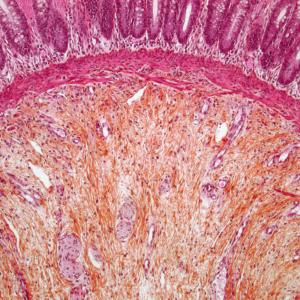
Rheumatologist Dr. H. Michael Belmont effectively treats a patient with lupus facing thrombocytopenia and anemia.
Photo: NYU Langone Staff
When confronted with a complicated case of thrombocytopenia, NYU Langone Health clinicians relied on expert knowledge and a meticulous strategy to investigate the condition and identify an effective treatment.
Timely Tests Reveal Severe Lupus Exacerbation Through Thrombocytopenia
A 34-year-old woman from Brooklyn who had been previously diagnosed with systemic lupus erythematosus (SLE), lupus nephritis, and end-stage kidney disease requiring hemodialysis encountered a new complication in April 2019. After providers at a dialysis center in lower Manhattan had difficulty accessing an arteriovenous fistula that had been grafted in her left arm to provide access for the dialysis, they transferred her to the emergency department at NYU Langone’s Tisch Hospital.
Once in the emergency department, doctors recognized that she was facing a more immediate threat of asymptomatic but severe thrombocytopenia: her platelet count of 168,000 in February 2019 had dropped to 2,000 in the emergency department. Serial lab tests upon her admission also revealed progressive anemia, with a significant drop in hemoglobin levels that continued to fall over the next 48 hours.
Differential Diagnoses Key to Determining Thrombocytopenia Etiology in Lupus
H. Michael Belmont, MD, professor in the Department of Medicine and medical director at NYU Langone Orthopedic Hospital, says clinicians should be aware of the broad differential diagnoses of thrombocytopenia in SLE. Most commonly, these include autoimmune thrombocytopenia (AITP) with antibodies to platelet membrane antigens (such as glycoproteins IIb/IIIa, Ib/IX, or Ia/IIa); AITP plus autoimmune hemolytic anemia (AIHA), also known as Evan’s syndrome; and a non-criteria manifestation of antiphospholipid syndrome.
Clinicians, though, also need to consider less common etiologies including those in which the thrombocytopenia is accompanied by evidence of a thrombotic microangiopathic hemolytic anemia (TMHA) process such as thrombotic thrombocytopenic purpura (TTP) with an immunoglobulin inhibitor of the ADAMTS13 protein. Other possibilities include complement-mediated hemolytic uremic syndrome (HUS) either as the consequence of an acquired immunoglobulin inhibitor of factor H or another complement regulatory protein, or coincidence in SLE of an inherited disorder of complement regulation. A deficiency of complement factor H–related plasma proteins and autoantibody-positive form of hemolytic uremic syndrome (DEAP-HUS) also may be seen in lupus. Rarely, HUS can occur due to the coincidence of a Shiga toxin–producing Escherichia coli (STEC) infection in a patient with lupus.
Other etiologies of thrombocytopenia in patients with lupus include disseminated intravascular coagulation (DIC); heparin-induced thrombocytopenia thrombosis (HIT/T); amegakaryocytic thrombocytopenia; acquired aplastic anemia due to humeral or cell-mediated inhibition of the myelopoietic progenitor cells, or both; hypersplenism with platelet sequestration secondary to cirrhosis or due to the splenomegaly that can be observed with nodular regenerative hyperplasia and non-cirrhotic portal hypertension; and coincidental drug-induced immune thrombocytopenia (DITP).
Recognizing Microangiopathic Hemolytic Anemia as a Mechanism of Thrombocytopenia Assists with Focusing Differential
The patient’s lab tests showed an absence of elevated double-stranded DNA or antiphospholipid antibodies, but modest hypocomplementemia. Dr. Belmont says the patient’s initial presentation raised concerns that she might have Evan’s syndrome with simultaneous AITP and AIHA. The case’s unusual presentation ran contrary to the general clinical rule that SLE disease activity is less intense with progression to end-stage kidney disease. The clinical team nevertheless started the patient’s initial treatment with parenteral steroids and intravenous gamma globulin, but her bicytopenia persisted. However, further testing revealed elevated lactate dehydrogenase (LDH), low haptoglobin, and a negative direct antiglobulin test result. Diagnostic testing also revealed the absence of spherocytes in the peripheral blood smear typical of AIHA, but the presence of significant schistocytes as seen with TMHA.
Based on the presence of TMHA in the setting of lupus, Dr. Belmont recommended an ADAMTS13 activity test, which showed an enzymatic activity of less than 5 percent. Based on a diagnosis of secondary TTP in SLE, NYU Langone doctors administered a treatment regimen of steroids, plasma exchange with fresh frozen plasma, and rituximab. The patient responded well, with her ADAMTS13 activity increasing to 90 percent. Additionally, her LDH and haptoglobin levels normalized, accompanied by improvement in her hemoglobin and hematocrit levels as well as an increase in her platelet count to 101,000.
A test for heparin-induced thrombocytopenia was positive for antibodies to platelet factor 4, although a negative result in the confirmatory serotonin release assay cast doubt on the diagnosis. Regardless, the medical team minimized the use of heparin with her hemodialysis out of an abundance of caution.
Appropriate Treatment Regimen Resolves Thrombocytopenia and Prevents Relapse
By mid-July 2019, the patient reported feeling well at a follow-up appointment, with no rash, alopecia, or arthritis, previous hallmarks of her SLE. Further, she had no fever, oral ulcers, shortness of breath, pleuritic chest pain, nausea, vomiting, abdominal pain, edema, or headaches. Her platelet count had rebounded to 170,000, and her ADAMTS13 activity remained high, at 81 percent.
Since her hospitalization, the patient has remained on a 5-mg dose of prednisone, 200 mg of hydroxychloroquine 3 times a week, and 1,000 mg of mycophenolate mofetil twice a day. She has not had a relapse of her thrombocytopenia since the initial event.
Dr. Belmont is providing maintenance courses of rituximab at six-month intervals to prevent a recurrence of TTP and reappearance of the anti-ADAMTS13 antibody. This case, he says, illustrates the potential for severe lupus exacerbation despite progression to end-stage kidney disease and initiation of hemodialysis. In addition, he says, it underscores the importance of considering TMHA as the mechanism of thrombocytopenia in patients with lupus with a differential diagnosis that includes secondary TTP on the basis of an acquired immunoglobulin inhibitor of ADAMTS13.
